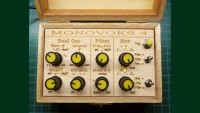Synthesizer MonoVoks4, analog filter Polivoks style

Music synthesizer with voltage controlled analog resonant filter and analog VCA. Double oscillator with wavemodulation and two loopable envelope generators. Potmeter control, MIDI control and patch storage.The PCB measures only 4.6 x 5.6 cm (excluding the wired up potmeters) . This design is offering a serious synthesizer (as far as synths can be serious), not a toy box. Sound examples of classic bass and lead sounds are included in the movie.
Concept: A newly designed monophonic music synthesizer operated by potmeters and switches without the need for menu's and display scrolling. The potmeters have very powerfull functionality by mapping several functions into them at once. This way a large reduction in potmeter count could be achieved while maintaining many possibilities.
The circuit is very compact, using a relative low number of components.
Available sound sources are: oscillators (square/saw/sine), noise/pattern generator and a click generator. In addition the analog filter can self-oscillate and become a very widerange sinewave oscillator (40Hz-12kHz).
Static sounds are not very interesting so there are a lot of modulation and control possibilities: The two oscillators have individual waveshaping LFO's. The two envelope generators can also, serve as LFO's. A dedicated LFO can add (key-down delayed) vibrato or filter "wah-wah". The Envelope generators can produce random and repeating patterns (sound examples and movie).
Sounds can be created, tuned and triggered on the unit itself but for playing a melody you can connect a MIDI keyboard. Using a MIDI keyboard with velocity varies the modulation depth and filterfrequency by how hard a key is pressed. The keyboard modulation wheel controls vibrato and the pitchbend wheel shapes the notes. Patches (synth sound setups) can be stored and recalled by sending MIDI
program changes from a keyboard or sequencer.A MIDI keyboard with controller potmeters can take over all potmeters remote, so you could also build a very compact MIDI-only version of this synth without potmeters, using the same PCB.
The analog part:
The voltage controlled analog filter is my design using only one opamp (well available) but it's principle is inspired by the Russion PoliVoks synth's filter (using 3 obsolete opamps). For detailed information on my filter design:
https://www.elektormagazine.com/labs/analog-synthesizer-filter-using-one-opamp
The VCA is based on one component, a so-called "vactrol". This is a LED coupled to an LDR in one lighttight package.This forms a LED-current controlled attenuator that handles large ac signals and has no control signal leakage.
The attack response is speeded up by a compensation RC in the LED control line (see circuit diagram). The analog hardware is essentially build around 2 opamps and the vactrol.
The digital part:
Using a lot of optimalisation, it became possible to run all the sound sources, the envelope generators and LFO's, the voltage control for the filter and VCA, the MIDI interface and user interface in the very small Arduino ProMini. The digital hardware is only this and an optocoupler for the MIDI input. As mentioned, the available PCB for the synthesizer measures only 4.6 x 5.6 cm. This is including the Arduino and optocoupler mounted on the PCB. The Arduino EEPROM is used to store/recall up to 64 synth setups, selected via MIDI program change messages. Having an analog signalpath following the digital oscillators prevents waveform DAC resolution limitations because the oscillator waves are always generated at full swing and are modulated by the filter and the VCA envelope, down to zero signal.
The oscillators:
These use so-called "Harmonic sampling", a method to prevent aliasing effects when making the synth waves. This is described in detail in the attached document: dig-oscillator-basics.pdf.
The case:
The housing is made from a wooden box (bought at a shop, Xenos, 2 Euro). The frontpanel is a wooden plate that is laser-cut and engraved. The frontpanel is fixed with little magnets to the box and can be lifted to give acces to the (re-) programming connector. The unit runs on an internal rechargeable battery or external 9V adapter that also charges the battery.
Attached are pictures, example sounds and the information needed for building the synthesizer. Additional information, like more example sounds and video's can be found on my personal website: www.rs-elc.nl






Updates from the author
RS-elc 3 years ago
RS-elc 3 years ago